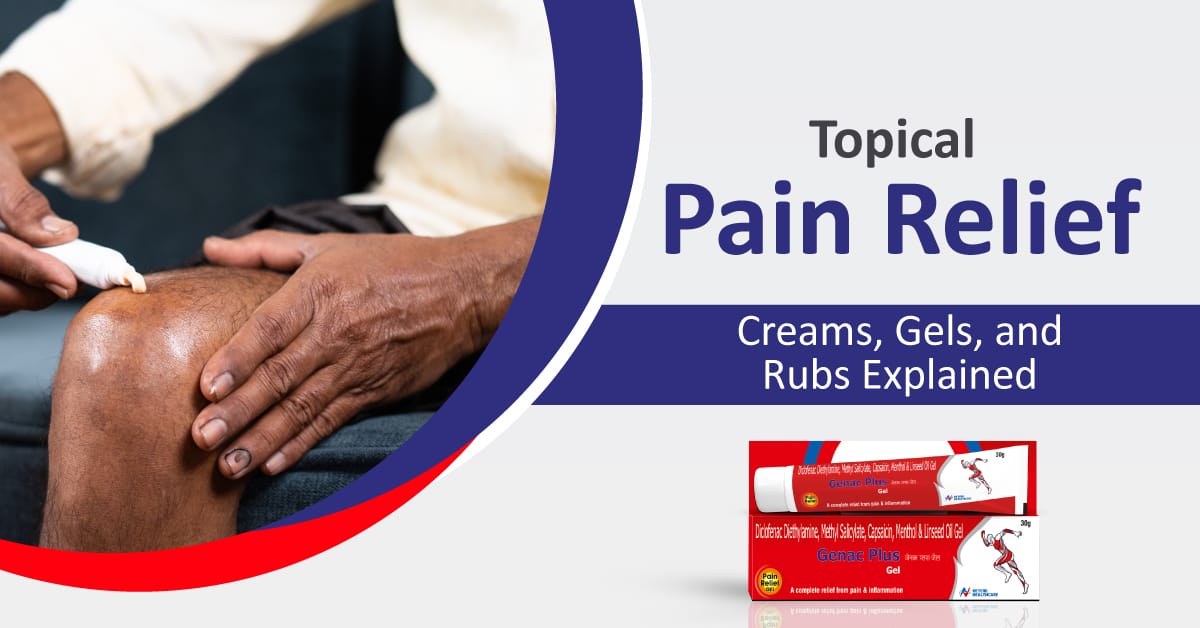Pain is one of the most common health concerns, affecting people across all age groups. From muscle soreness after exercise to chronic joint pain caused by arthritis, finding relief is essential for maintaining mobility and quality of life. While oral pain medications are widely used, many people prefer topical pain relievers-creams, gels, and rubs-for their targeted action and fewer side effects.
In this blog, we’ll break down what these products are, how they work, and when to use them, so you can choose the right option for your needs.
What Are Topical Pain Relievers?
Topical pain relievers are medications applied directly to the skin over the area of discomfort. Instead of circulating through the bloodstream like oral drugs, they act locally, targeting muscles, joints, and tissues just beneath the skin.
These products are available in various forms-creams, gels, sprays, patches, and rubs-and often contain ingredients like:
- NSAIDs (Diclofenac, Ibuprofen)
- Menthol and Camphor (cooling/warming effect)
- Capsaicin (from chili peppers, reduces nerve pain)
- Lidocaine (numbing agent)
Types of Topical Pain Relief Products
Pain Relief Creams
- Usually thick, moisturizing, and easy to spread.
- Often contain menthol, camphor, or salicylates for a soothing effect.
- Best for surface-level pain such as mild muscle soreness, stiffness, or minor injuries.
- Absorb slower compared to gels, providing longer-lasting relief.
Pain Relief Gels
- Lightweight and fast-absorbing.
- Provide a cooling sensation thanks to menthol or alcohol-based formulations.
- Ideal for acute injuries, sports-related strains, and joint pain.
- Less greasy than creams, making them suitable for daytime use.
Looking for a trusted option? You can try Genac Plus Gel, a fast-acting topical gel designed to relieve muscle and joint pain with effective anti-inflammatory ingredients.
Pain Relief Rubs and Balms
- Thicker and oil-based, offering warming or tingling effects.
- Contain strong counterirritants like capsaicin or camphor.
- Great for deep muscle pain, backaches, and arthritis-related stiffness.
- Often used at night because of their intense sensation and longer absorption time.
How Do They Work?
Topical pain relievers provide relief through different mechanisms:
- Counterirritation-Ingredients like menthol or camphor cause cooling/warming sensations that distract the brain from pain.
- Anti-inflammatory action-NSAID-based gels reduce inflammation in joints and muscles.
- Nerve desensitization-Capsaicin reduces levels of substance P, a chemical that transmits pain signals to the brain.
- Numbing effect-Lidocaine blocks nerve signals, offering temporary relief for nerve-related pain.
Since they work locally, systemic side effects are minimal, making them safer for long-term use compared to oral medications.
When to Use Topical Pain Relievers
Topical pain relief is best for localized, mild to moderate pain, including:
- Muscle strains and sprains
- Sports injuries
- Back and shoulder stiffness
- Arthritis-related joint pain
- Minor bruises or inflammation
They are particularly helpful for individuals who cannot take oral NSAIDs due to stomach, kidney, or heart issues.
Advantages of Topical Products
- Targeted relief-Works exactly where applied.
- Fewer systemic side effects-Minimal risk to liver, kidneys, or digestive tract.
- Quick action-Absorbs fast and starts working within minutes.
- Easy to apply-No need for water, pills, or prescriptions (in most cases).
- Variety of options-Creams for long-lasting relief, gels for fast absorption, rubs for deep heat therapy.
Limitations and Precautions
While topical products are generally safe, they are not without limitations:
- Limited depth-They mostly affect surface-level pain and may not work for severe or internal conditions.
- Skin irritation-Some people may experience redness, itching, or burning.
- Shorter duration-Relief often lasts a few hours and requires reapplication.
- Not a cure-They treat symptoms but don’t address underlying conditions.
Precautions:
- Do not apply on broken or infected skin.
- Avoid using with heating pads (may increase absorption and risk of burns).
- Wash hands thoroughly after application.
- Consult a doctor if pain persists beyond 7-10 days.
Tips for Safe and Effective Use
- Follow instructions on the product label for dosage and frequency.
- Apply a thin layer and massage gently for better absorption.
- Target the right areas Apply only where pain is present.
- Don’t mix multiple topicals unless approved by a doctor.
- Combine with lifestyle changes like stretching, rest, and physiotherapy for maximum benefit.
Conclusion
Topical pain relief products-whether creams, gels, or rubs-are a safe and effective way to manage localized pain. While creams offer longer-lasting relief, gels work quickly without greasiness, and rubs provide deeper heating effects for muscle and joint pain.
If you’re considering a reliable option, Genac Plus Gel is a proven choice for fast-acting, localized relief.
They may not replace oral medications in all cases, but for targeted, everyday pain relief, they are an excellent first choice. Always choose the right formulation based on your pain type and consult a healthcare professional for persistent or chronic pain.
By understanding how these products work and using them correctly, you can manage pain more effectively and improve your overall quality of life.



